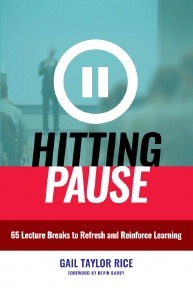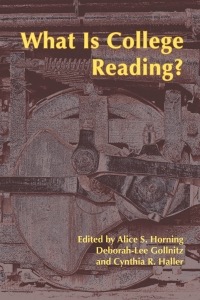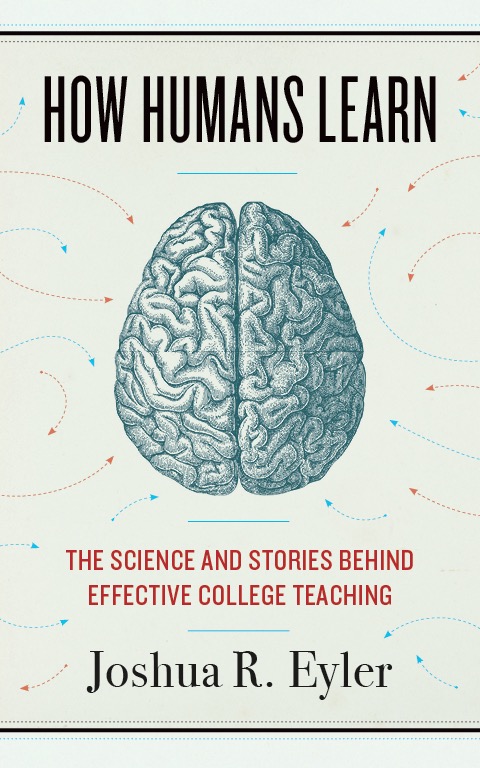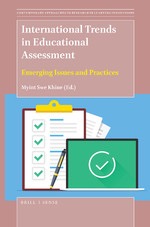student learning
Select an item by clicking its checkbox

Hitting Pause: 65 Lecture Breaks to Refresh and Reinforce Learning
Date Reviewed: January 23, 2019
Timing is everything. It’s true for comedians and, according to Gail Taylor Rice, also for professors. Great comedians can hold an audience’s attention for over an hour because the attack-and-retreat nature of human attention. They know about volume control; high volume must be properly balanced with lower volume. Fast tempos must be tempered with slower tempos.
In the book Hitting Pause, Rice makes a compelling argument in favor of recognizing and designing classes in light of the rhythms of learning. Professors often suffer from the cognitive bias of "the curse of knowledge." This malady makes it nearly impossible for experts to put themselves in the shoes of someone who is learning things for the first time. A result of this curse is that it’s nearly impossible to appreciate how much time is needed for comprehending material.
Rice suggests that learners "might wish that there was a pause button connected to their college professors" (4). The pause button is a great metaphor. I think this idea could also be expanded as a highlighter pen for the lecturer. The professor needs to frequently slow down and make sure that students understand the importance of certain ideas.
The book rightly challenges the status quo of today’s university classroom as a place where professors read PowerPoint slides in darkened rooms while the gravitational pull of more interesting things like Instagram claim the student’s valuable and limited attention. Rice suggests that well-timed pausing can introduce the right kind of novelty and reflection to pull students out of their penchant for succumbing to time-wasting distractions.
Many educators believe the lecture is dead, and good professors will not use them. Lectures, however, aren’t necessarily bad; only bad lectures are bad. Rice offers solid research to give professors tested strategies for designing effective lectures that are punctuated with well-timed opportunities for reflection and emphasis.
According to Rice, starting a class with a pause invites students to become emotionally invested in learning. Again, we are so busy planning what we will teach that we forget to see things from a student’s perspective. An intentional pause forces us to think of starting a class like a pilot preparing for take-off. A good pilot will dutifully attend to a check-list to make sure that the plane is in good condition; teachers also need to consciously attend to their students’ current ability to learn.
The first half of Hitting Pause provides solid research about the pedagogical advantages of pausing. The second half contains numerous examples of starting pauses, mid-pauses, and closing pauses. Each example is categorized by appropriate setting and characteristics for use. The settings for use are divided into small classroom lecture, clinical or laboratory presentation, one-on-one session, conference presentations/in-service education, keynote/large-group presentation, course/unit, and online learning module. The characteristics include: affirming/positive, physical/movement, activates prior knowledge/experience, focuses/refocuses, creates community, generates curiosity, metacognitive, reviews, celebrates, commits to action, and provides a bookend. There are a great variety of examples which can be adapted to work in different settings.
Overall, this is a valuable book for teachers who are hoping to be more learning-centered.
Date Reviewed: June 17, 2021

What is College Reading?
Date Reviewed: January 18, 2019
Co-published by CSU Open Press
What is college reading? As college teachers we may assume that it is a process of comprehension, analysis, synthesis, and evaluation. But, as this edited volume overwhelmingly demonstrates, that is often not what it is for college students. How then can college teachers help students practice advanced reading skills? The problem is compounded by the fact that even college teachers who actively want to encourage students to read may unwittingly discourage advanced reading skills by, for example, giving reading quizzes in class (as discussed by Mary Lou Odom in this volume). This edited volume is a great resource for anyone wishing to engage questions about how to improve college reading.
Some chapters provide useful practical suggestions. For example, Chris Anson shows how to formulate reading log prompts that require students to engage with the underlying ideas in the reading. Other chapters describe exercises such as in-class annotations (Davies) and says-does columns (Huffman). The volume also contains several insightful discussions of other factors influencing college reading that are more difficult to address, but no less important. For example, some of the authors observe that reading, which we may think of as an individual activity, is a “complex sociolinguistic task” (Hollander et al., 59), and “a collective and holistic enterprise” (Maloy et al., 71). Brian Gogan provides a thoughtful reflection on reading in relation to “threshold concepts” (concepts that students need to grasp in order to move forward in a given disciplinary context). College teachers may use these insights to make reading part of building an intellectual community in the class.
The chapter by Young and Potter discusses how students are taught to read in K-12, where students are commonly given a decontextualized passage and then tested on their ability to understand inferences at the level of sentences or paragraphs. These students also commonly learn that for each question asked about the text, there is one correct answer in a multiple-choice format. They receive comparably little training in the advanced reading skills required for college, such as learning how to place a particular text into a connected web of texts that make up an ongoing disciplinary conversation, or asking their own higher-order questions and working with others’ questions that do not have a single “correct” answer. When students start college, therefore, they will commonly think of reading as looking for answers in a decontextualized excerpt; they are not accustomed to looking instead for interesting, productive problems in a web of texts (as also discussed in the afterword by Sullivan and Tinberg).
Other authors discuss the importance of instructors connecting reading with writing, drawing on both the writing-to-read and reading-to-write conversations (Anson; Freedman). Some chapters refer to the by now widely known finding that the majority of students do not do what their instructors think they do when completing a research paper assignment, and how to address the implications of this for formulating new types of writing assignments (Horning; Young and Potter). Related to this, Laura Davies points out in her chapter that students who write poorly are usually referred to the university’s writing center, rather than asked about their reading skills, which underlie their writing. Several chapters also touch on how reading might be given a stronger institutional footing through, for example, being explicitly incorporated into writing-across-the-curriculum initiatives (Odom), linking courses (Sturtz et al.), or providing a reading-across-the-curriculum community on campus (Hollander et al.).
In sum, as Leonora Freedman observes in her chapter, stronger responses to the problem of how to teach college reading skills can lead to increased student engagement as well as increased faculty morale. This edited volume is a very good place to start. It deserves a wide readership among college faculty and administrators, and this goal will no doubt be made easier by the fact that the publishers have made it free to download at wac.colostate.edu.

How Humans Learn: The Science and Stories behind Effective College Teaching
Date Reviewed: January 18, 2019
How Humans Learn argues that our natural systems for learning are connected to human evolution and psychological development, and a better understanding of the way humans learn can help determine what will and will not work in the classroom. Instead of presenting evidence of why a teaching or learning strategy works, Eyler identifies five patterns of learning drawn from psychology, evolutionary biology, and neuroscience to explain why students learn more when certain techniques are chosen over others: curiosity, sociality, emotion, authenticity, and failure. He draws on seminal works in the scholarship of teaching and learning such as that of Bain (What the Best College Teachers Do, 2004) and Fink (Creating Significant Learning Experiences, 2013), and his patterns overlap with principles of learning identified by other scholars (Ambrose et al., How Learning Works, 2010; Davis & Arend, Facilitating Seven Ways of Learning, 2013).
In each chapter Eyler offers examples of classroom practice from various disciplines in Western higher education and provides helpful “key takeaways” that summarize major points and highlight practical suggestions. For example, to stimulate curiosity we can incorporate inquiry, discussion-based pedagogies, and backward design that structures courses from the outset so that every element is tied to an essential question that our course helps students answer (Wiggins & McTighe, Understanding by Design, 2005). To promote sociality, we can use collaborative learning strategies, peer instruction, storytelling, and role-immersion games such as Reacting to the Past. To ensure that emotions guide thinking rather than undermine it, we can demonstrate the relevance of the material and embody “pedagogical caring” by giving frequent feedback, having high expectations for students, and coming to class prepared. To encourage an authentic learning experience, we can allow students to engage in applied problem solving, incorporate experiential and service learning, and bring our own research into the classroom. Finally, we can allow students opportunities to fail when the stakes are low, then give them support and guidance to understand from failure and cultivate growth mindsets, grit, agency, and other resiliency strategies.
Those fascinated by evolutionary developmental biology will likely enjoy the entire book, while others may gravitate towards particular chapters that address topics of interest. Eyler mentions religion only once in the book, during discussion of the “emotional trauma” that can result when students alter knowledge structures or “mental models” tied to their personal beliefs and deeply held convictions (192), but his discussion of “cognitive realism” – when the brain registers a situation as being realistic – also poses interesting challenges for instructors of religion (154). Theological education affords various types of immersive experiences for students, but what sorts of “authentic activities” and “immersions” might instructors of religious studies offer students, especially those who teach in public colleges and universities? Although there are clearly opportunities to apply tools and methodologies from the study of religion to conduct field research or wrestle with problems of the world (155), what characteristics would make other assignments or activities “compellingly” real (157) without being religious?

Designing a Motivational Syllabus: Creating a Learning Path for Student Engagement
Date Reviewed: January 18, 2019
This book helps teachers think through the many functions and possibilities of the course syllabus, particularly as seen through the eyes of students. The authors advise thinking of the syllabus as a motivational tool rather than a punishing list of policies or a repository for contractual language; moreover, they suggest embedding more visual tools and images as well as more explicit rationales for assignments, even down to the individual class level. All of what they propose seems simple and reasonable, even for busy faculty. The authors clearly aim to help faculty see the excitement of creating “a course design tool that maps out the learning path for students” (19), and their suggestions will prove most useful to those beginning teaching who want to break out of the graduate school reading list mode and to those further on in careers, particularly those who might have changed (or want to change) their teaching strategies.
Harrington and Thomas write in an accessible and encouraging style throughout. After a brief consideration of the history and purpose of the syllabus in Chapter 1, they address the following issues in turn: applying course design principles with an emphasis on backward design; key components of any syllabus; policies and other boilerplate; issues of design; techniques for getting feedback and evaluating the syllabus; and ways of using the syllabus beyond its traditional roles. They helpfully include a sample syllabus as well as a syllabus checklist and sample grading rubrics. They lay out the main types of syllabi (coverage-based and activity-based) and argue for the superiority of a backward design that works from goals for students rather than from content or activities. They also champion Fink’s taxonomy of significant learning over Bloom’s, a distinction without a difference to readers who steer clear of learning taxonomies.
Many of the suggestions here seem more suited to a quick tutorial than a full-length book, particularly for seasoned faculty. But the biggest surprise is that this book scarcely addresses online learning management systems, an essential part of many courses that has, in some cases, completely replaced the single-document syllabus. Omitting this technology leaves a huge gap. This book would be greatly improved with a consideration of how the purpose and form of the syllabus has changed with the rise of learning management systems and how the principles described here apply to syllabus design in that context.
Harrington and Thomas rightly see the syllabus as a document that communicates expectations while explaining why the work of the course matters. Much of their focus is on tone and balance: even subtle changes in language and a careful curation of policies, such as those related to student behavior in class, can pay dividends in making students feel more positive and motivated to take on the work of the course. Although this book is not specific in any way to religious studies or theology, any teacher can benefit from a reminder of ways to improve this most standard of course materials.
